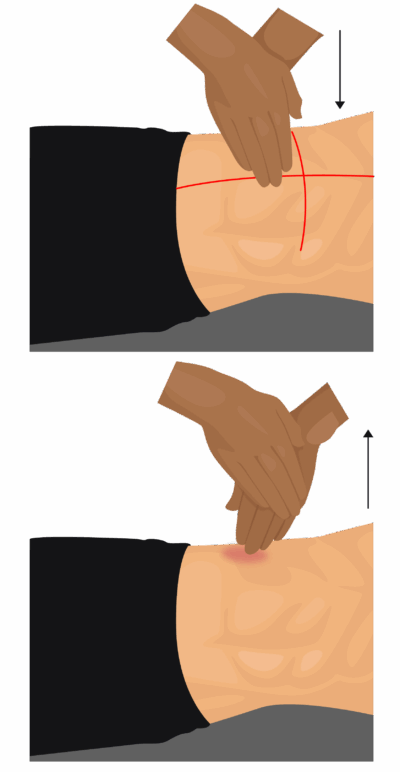Blumberg’s Sign
The Blumberg’s sign (also known as Rebound Tenderness Test) is a medical exam maneuver used to detect peritoneal irritation, most notably in acute conditions such as appendicitis or other causes of peritonitis.
It is not a musculoskeletal or massage-oriented test; it is an acute abdominal red-flag test.
How to Perform the Test
-
The client lies supine with the abdomen exposed and relaxed.
-
The examiner presses slowly and deeply into the abdomen over an area of concern (often the right lower quadrant in suspected appendicitis).
-
After holding for a couple of seconds, the examiner suddenly releases the pressure.
-
Positive test (rebound tenderness / Blumberg’s sign):
-
The client experiences more pain on release than on application of pressure.
-
This indicates irritation of the peritoneum (e.g., appendicitis, perforation, generalized peritonitis).
-
This is distinct from simple “abdominal tenderness,” where pain occurs as pressure is applied rather than on release.
Clinical Significance
-
A positive rebound tenderness test strongly suggests peritoneal inflammation and possible surgical abdomen (e.g., appendicitis, perforated ulcer, diverticulitis with perforation).
-
Because peritonitis and acute appendicitis can be life-threatening and time-sensitive, rebound tenderness is considered a medical emergency sign, not a routine screening finding.
Assessment
-
Massage therapists should not perform deep palpation or rebound testing of the abdomen as part of a typical massage assessment; this is a medical diagnostic maneuver.
-
However, knowing what rebound tenderness means helps you recognize when abdominal pain is a red flag requiring immediate medical referral, not manual treatment.
Treatment
-
Massage should not be used to “relieve stomach pain” when serious intra‑abdominal pathology is possible.
-
Avoid:
-
Deep abdominal work.
-
Strong pressure around the lower right quadrant or any area of acute pain.
-
Heat or other modalities over a potentially inflamed abdomen.
-
-
Once a client has been medically assessed and treated (e.g., post-appendectomy, resolved peritonitis) and is cleared for manual therapy, you may work supportively on postural, back, and breathing patterns, but not on the acute abdomen itself.
Safety and Referral
If a client reports any combination of the following, especially with acute onset, do not treat; instead advise urgent medical evaluation:
-
Sudden or progressively worsening abdominal pain, especially if localized (e.g., right lower quadrant).
-
Pain that is sharp or severe when they “let go” after pressing on their own abdomen (they may describe this spontaneously).
-
Associated fever, nausea, vomiting, loss of appetite, abdominal guarding, or rigidity.
In these cases, massage therapy is contraindicated until a physician has evaluated and cleared them.

